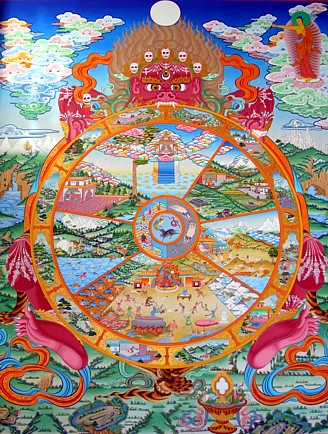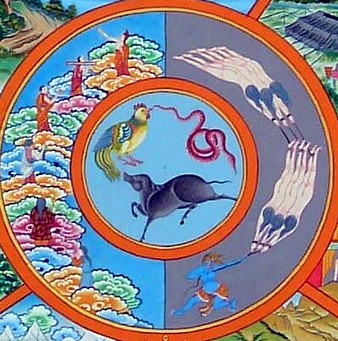Wheel of Life

Wheel of Life (Wyl. srid pa'i 'khor lo) - a traditional representation of the samsaric cycle of existence.
Overview
The Wheel of Life is a traditional representation of the samsaric cycle of existence. The wheel is depicted in three or four layers, all held within the grasp of Yama, the Lord of Death.
The layers of the wheel are:
- Center: represents the three poisons
- Second layer: this layer varies and is not included in some drawings of the wheel.
- Third layer: represents the six realms of samsara
- Fourth layer: represents the twelve links of interdependent origination
Center of the Wheel

Ringu Tulku Rinpoche said:
- Tibetans have a traditional painting called the Wheel of Life, which depicts the samsaric cycle of existence. In the center of this wheel are three animals: a pig, a snake, and a bird. They represent the three poisons. The pig stands for ignorance, although a pig is not necessarily more stupid than other animals. The comparison is based on the Indian concept of a pig being the most foolish of animals, since it always sleeps in the dirtiest places and eats whatever comes to its mouth. Similarly, the snake is identified with anger because it will be aroused and leap up at the slightest touch. The bird represents desire and clinging. In Western publications it is frequently referred to as a cock, but this is not exactly accurate. This particular bird does not exist in Western countries, as far as I know. It is used as a symbol because it is very attached to it's partner. These three animals represent the three main mental poisons, which are the core of the Wheel of Life. Stirred by these, the whole cycle of existence evolves. Without them, there is no samsara.[1]
Second Layer of the Wheel
This layer varies and is not included in some drawings of the wheel.
Third Layer of the Wheel
The third layer of the wheel depicts the six realms of samsara.
Fourth (Outer) Layer of the Wheel
The fourth layer of the wheel depicts the twelve links of interdependent origination.
Internal Links
Notes
- ↑ Daring Steps Toward Fearlessness: The Three Vehicles of Tibetan Buddhism, by Ringu Tulku, Snow Lion, 2005 page 30.